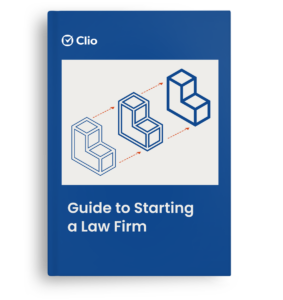I’d like to let you in on a secret. Working as in-house counsel within a large organization doesn’t mean you need to spend six figures on ‘enterprise’ software just to run your practice.
I put this assertion to a test, literally, when I took an in-house role three years ago. Joining one of the nation’s largest mortgage servicers as a senior defense attorney, I found myself in an ocean of mortgage data managed by a longstanding but clunky enterprise resource planning system that runs on DOS.
The need for practice management software
You know that feeling you get when your computer is taking especially long to boot up for some reason?
Imagine having that feeling every time you did a search for a client. That was my life before bringing in a practice management system.
Based on my experience in mortgage marketing early in my career, I could see that we would not be able to handle the company’s expected transaction growth (ultimately a tenfold increase in loans over three years) without some sort of legal customer relationship management (CRM) tool. So, even though I had only recently joined the company, I pushed my colleagues and our finance team to look at some big-ticket enterprise practice management software. Better to head the problem off early than to risk not being able to handle that growth with our DOS system.
We started down the path with the on-premise enterprise software vendor, scoping out the project on a number of conference calls.
And then a funny thing happened.
More expensive is not always better
As expected, the price tag for this enterprise software was going to be in the hundreds of thousands of dollars. Feeling uneasy with this, I was compelled to ask, “Hasn’t anyone found a better way to do this?”
After a bit of searching, Google supplied an intriguing answer—cloud-based solutions that could perhaps do the job for a tenth the price. The question was, could Clio, the platform used far and wide by 20 person law firms, be the solution for a 20 person legal department inside a much larger company?
Imagining the looks of pure joy on the faces of our finance team if I could pull this off, I set to work rigorously testing Clio against the enterprise vendor we were looking at. For a few weeks, it was basically Michael Phelps vs. the Shark in our office, all of us curious to see which solution would win out.
With some heavy lifting, the on-premise enterprise software could be configured to handle all the data in the company. But the beauty of using the cloud was that we could make all the customizations we needed right from our desktops.
Also, the enterprise vendor told us they wanted six months to configure their solution and two weeks to train us. Meanwhile, by the time the scoping was done, I had Clio set up and running! It took me one hour to train the team on a web conference.
In the end we went with Clio and saved a ton of money—and, frankly, a lot of hassle—that would have come with setting up a complex on-premise system.
You may like these posts
4 tips for finding the right practice management software for you
With the right technology, you can bring numerous efficiencies to your in-house practice. Here are a few tips I’ve learned about choosing software solutions that will help you succeed without breaking the bank:
1. Look for a solution that works with the other tools you use
It’s harder to build a bridge than to cross one. Make sure your practice management system integrates directly with your chosen email and document management tools. For example, we use Gmail and Google Docs. These sync with our practice management system, so it’s easy to attach any document in a given matter to an email going out to one of the parties.
2. Find features that make you faster
When it’s your job to field incoming legal actions, things can happen quickly. I could have my day carefully planned out, and then find when I walk in that someone on the east coast has filed a temporary restraining order that I need to respond to immediately. At times like these, I really value built-in document automation that lets me generate new letters with client information automatically inserted. In addition, having a platform that helps me securely share documents with our external counsel keeps things moving seamlessly.
3. Answer roadblock questions upfront
Slow and clunky systems aren’t just painful to use—they’re painful when you want to move to another system. You will inevitably have questions from other departments so be prepared to answer them upfront.
For example:
- Make sure to scope out all the features you need at the start so that you have a finalized budget for your finance team and don’t need to go back with add-ons. Fortunately, if you want to go the SAAS route, cloud-based solutions tend to have a lot less add-ons than on-premise software.
- Learn how your potential legal practice management provider will support you in migrating data from your old system to your new system, so that your IT department will know what to expect. (Will it cost you extra? How long will it take?)
- Get the details on how secure your data will be (does it use bank-grade 256-bit SSL encryption like Clio does?) so that everyone at the company can rest easy knowing that key company data is safe.
What’s the benefit to your internal clients if you have an easy, secure way to connect remotely—and what’s the risk if you don’t? As someone who’s made the jump, I can tell you that accessing information in the cloud, whether on laptop or phone, is incredibly easy and fast. You definitely don’t want to find yourself trying to hack into the company mainframe while you’re on a date (been there). Asking the right questions upfront will help bring all parts of your organization on board.
4. Do a worst-case scenario assessment
Are you prepared for the worst day your organization could have? Plot out those nightmare scenarios (you’ve been hacked, all of your data disappears, there’s a fire in the office, Jill wins the lottery and leaves the rest of the team high and dry), and go through what plans are in place to mitigate them with your potential new practice management tool. Then, go through those plans again with your current system. Often, the risk of not changing is even higher than keeping the status quo.
Practicing law in-house requires a lot of collaboration—both inside and outside the legal department—so you need to consider using new technology tools from a variety of viewpoints. But the truth about enterprise software for lawyers is that, if you do your research well, the perfect solution doesn’t have to come at an enterprise cost. Believe me, the cloud is there for you.
About Stephanie
Stephanie Saxton is Senior Defence Litigation Specialist at Penny Mac Loan Services. She began her career in the media industry and recently practiced as an attorney with Masry & Vititoe and Bank of America. Stephanie is a graduate of the University of Southern California and Southwestern University School of Law.
We published this blog post in October 2017. Last updated: .
Categorized in: Business, Technology








